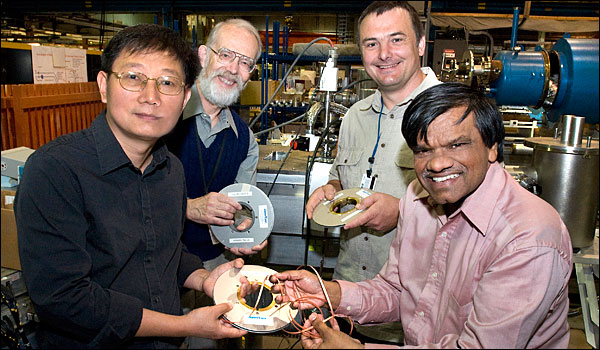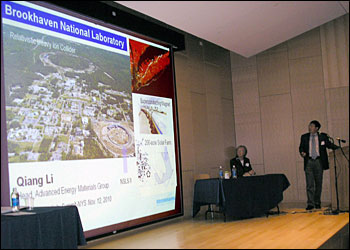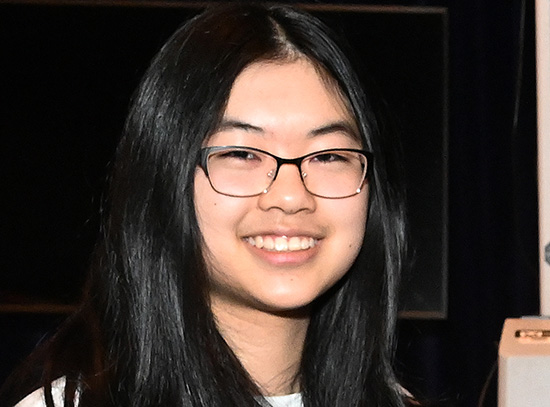Brookhaven Lab Materials Scientist Participates in Statewide Superconductivity Summit
December 13, 2010
Qiang Li, head of BNL’s Advanced Energy Materials Group, principal investigator of DOE Basic Energy Science’s Superconducting Materials Program and principal investigator for the Lab’s efforts to design and build a superconducting magnet energy storage system, gave a presentation as part of the recent New York State Superconductor Technology Summit. The one-day conference, held on the campus of Westchester Community College in Valhalla, featured three panel sessions on aspects of superconductor technology. Li’s panel session, on the state of large-scale superconductor technology, also had panelists from SuperPower, Inc., General Electric, Phillips Medical and Qdrive.

The Brookhaven team working on the superconductor magnet energy storage system (SMES) project are, from left Principal Investigator Qiang Li, Condensed Matter Physics & Materials Science Department (CMPMSD) Peter Wanderer, Superconducting Magnet Division (SMD), Vyacheslav (Slowa) Solovyov, CMPMSD, and Ramesh Gupta, Principal Investigator for SMD.
Unlike ordinary conductors, superconductors carry current with zero resistance so that no energy is lost. Brookhaven researchers seek to improve the critical properties of known superconducting materials and accelerate the search for new superconducting materials. Ultimately the research is aimed at improving the capacity, efficiency, and reliability of the electric grid. These are crucial issues for Long Island, New York State, and the nation, especially as demand continues to rise and as substantial renewable energy sources like the sun and wind are integrated into the system.
“Our work begins at the nanoscale and gets big, “ Li observed. BNL’s Advanced Energy Materials Group conducts its basic scientific research in collaboration with the Electron Spectroscopy, Neutron Scattering and TEM groups. Using Brookhaven’s advanced tools through the Center for Functional Nanomaterials (CFN) and the National Synchrotron Light Source (NSLS), the groups also work closely with the Center for Emergent Superconductivity, one of 46 recently created Energy Frontier Research Centers (EFRCs). The Brookhaven EFRC will seek to understand the underlying nature of superconductivity in complex materials.

Qiang Li gives his presentation at the New York State Superconductor Technology Summit.
Developing affordable, large-scale energy storage systems would be a game-changing advance for the U.S. electrical grid. In particular, energy storage will be crucial in enabling the widespread use of two key renewable energy sources: wind and solar power. Superconducting magnet energy storage (SMES) systems use magnetic fields in superconducting coils to store energy with near-zero energy loss, and have instantaneous dynamic response and nearly infinite cycle life.
Brookhaven’s SMES project, one of 43 being funded with $92 million from the American Recovery and Reinvestment Act through DOE’s Advanced Research Projects Agency-Energy (ARPA-E) is a collaboration between Brookhaven Lab, ABB, Inc. of Cary, NC, SuperPower, Inc. of Schenectady, NY, and the University of Houston. The group will receive $5.25 million ($4.2 million directly from ARPA-E, $1.05 million matching) for a project titled "Superconducting Magnet Energy Storage System with Direct Power Electronics Interface.” Scientists at Brookhaven’s Magnet Division will lead the design and development of the SMES coils and support structure, while Advanced Energy Materials Group will collaborate with SuperPower, Inc., a leading high-temperature superconducting (HTS) wire manufacturer, in the development of second-generation HTS wires.
Brookhaven has a long history with applied superconductivity research and development, and hosted the first Applied Superconductivity Conference in 1966. Citing the development of MRI technology for medical imaging, Li observed that “superconductivity saves peoples’ lives.” It can also improve the efficient delivery of electricity, a high priority for the nation today. From 1972 to 1986, BNL’s Power Transmission Project tested a prototype superconducting 100-meter cable capable of carrying over 600 MVA, equal to the power output of a medium-sized nuclear reactor. The cable proved to be extremely durable, and in 2008, the Long Island Power Authority (LIPA) commissioned the first high temperature superconducting power cable system, capable of carrying 574 megawatts of power, at its Holbrook site.
2010-2143 | INT/EXT | Newsroom









